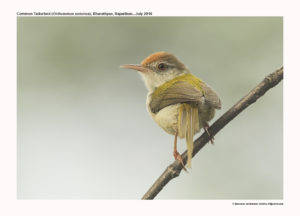
Common Tailorbird Orthotomus sutorius
Etymology:
- Orthotomus : Greek word orthotomeo – to cut straight.
- Sutorius: Latin word for one who stiches derived from suere –to stitch, sew
Vernacular Names : Hindi: Darzee, Darzan, Phutki, Piddi, Pun: Darji, Ben: Tuntuni, Ass: Paatxla sorai, Cachar: Noni dao teetee, Nepal: Patia, Guj: Tashko, Darjido, Mar: Darzee, Phutki, Piddi, Shimpi, Ta: Thaiyalkaran-kuruvi, Koddia-pakkan, Thaiyal chittu, Pon chittu, Te: Likka jitta, Mal: Panakkuruvi, Kan: Simpiga, Darji, Sinh: Battichcha, Tawika
Distribution in India: Widespread resident in India.
Description: Size of 10–14 cm; wt. of 6–10 g. It is a cock-tailed green and greyish warbler with relatively long pale bill slightly decurved towards tip, and somewhat flattened. The male of nominate race is rufous from forehead and lores to well down nape. It has buffish ear-coverts; upperparts, including upperwing and tail are yellowish green, concealed portions of wing are ash-brown; central pair of tail feathers have tapering extensions ; throat and underparts are white, faintly washed buffish, tibia is feathering rufous; iris is reddish yellow; upper mandible is brown, cutting edges and lower mandible has yellowish flesh; legs have yellowish flesh. The female has tail shorter than males and lacking extensions of central rectrices. The juvenile is duller than adult, with crown and nape olive, eyes are dark brown.
Habitat: It is found in bushy cover by villages, gardens and parks, even shrubbery in city centres, forest edges, plantations and mangroves. It is found from lowland up to as high 2100 m.
Food habits: It eats tiny invertebrates, insects like small beetles, bugs, ants and flies, small butterflies and, nectar and flowers. It is found in pairs, feeding within cover. It works its way up through tangled vegetation, vines etc. It forages on ground under cover of shrubbery, hopping with tail held cocked and flicked from side to side. It flies weakly, with tail twitching, moving only short distances between bushes.
Breeding habits: They breed in Mar–Dec in India, coinciding with wet season and throughout the year in Sri Lanka. They have a long-term pair bond. The male sings with long tail cocked high and with head up, exposing dark patches of bare skin at sides of throat. The nest is a deep cup of spider webs and egg-bags, wool, down or cotton, lined with fibres, constructed within cone of larger leaves which are stitched together to form pocket. The nest is built by female, using material brought by male. The nest building takes 4 days. The female selects suitable leaves, pierces a series of holes around perimeter of each leaf, and finally threads strands of fibres through holes, pulling fibres through quite tightly .The repairs are undertaken at frequent intervals, especially during monsoon. They lay a clutch of 3–5 eggs. The incubation is done by both sexes for a period of 12 days. The nestlings are fed by both sexes. The nest is parasitized by Plaintive Cuckoo.